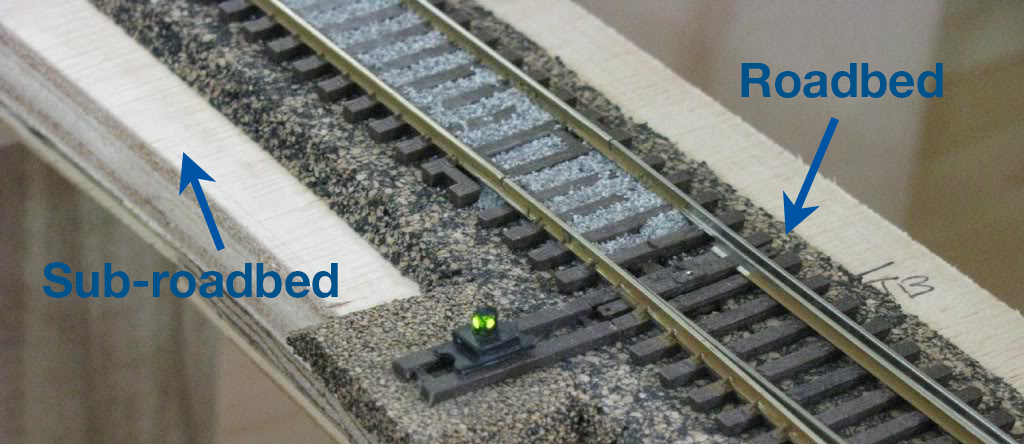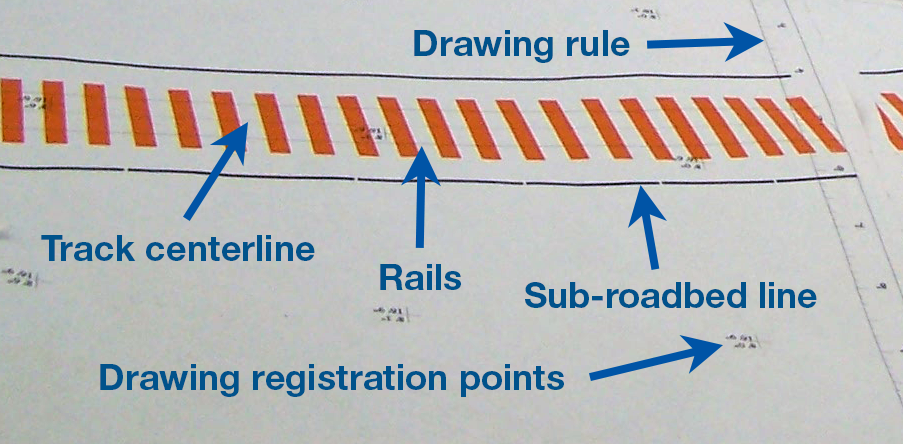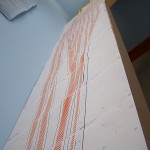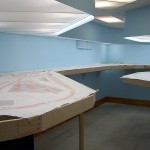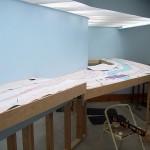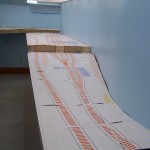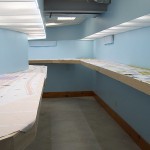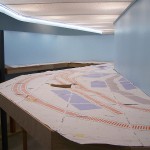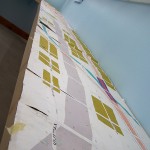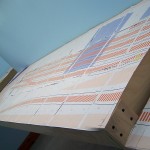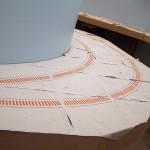I have finally reached a point where the LK&O will begin to actually look like a railroad. It is time to build sub-roadbed and lay track. As you can see in the picture gallery below, the trusty old paper track plan is in place on the benchwork. The poor paper has been through a lot over the past three years. It spent two years on the floor being walked on, having benchwork constructed on top of it, and basically acting as floor covering. It also spent a year wadded up in the corner during a period of time when it wasn’t needed. The wear and tear has taken its toll but fortunately it has but one last duty before it hits the trash can. The plan will serve as my template for cutting sub-roadbed to shape and locating it on the benchwork.
It should be noted the lines I have labeled as sub-roadbed on the drawing are actually roadbed lines. Sub-roadbed is normally wider than the cork roadbed. Since I am placing sheet foam right up against my sub-roadbed it is not so critical the sub-roadbed be wider than the roadbed. Drainage ditches and other similar trackside features will be carved directly into the foam.
In case you are not familiar with the terminology:
I found this track image on the web long ago. I do not remember who posted it. To whoever owns this picture my apologies for not being able to credit it to you. BTW the LED switchstand idea is killer! I absolutely must have these on my railroad.
EDIT thanks to Jas for pointing me to the LED switchstand site. Thanks to Bob Farrell for the slick idea.
Closeup of the paper plan so you know what I am working with.
There are several places on the paper plan that have not survived the ordeal. I have to reprint some pages and splice them in to repair the damage before I commence sub-roadbed cutting. Alignment of the various pieces is important so I must make these repairs before proceeding. Once the paper plan is repaired the process I have in mind goes something like this:
- Reinforce with clear packing tape each seam in the paper where track crosses from sheet to sheet.
- Stretch and pin the paper plan tighter than it is now.
- Divide the plan into sections that can be cut from a single sheet of plywood (no section can exceed 8′ in length). Try to keep areas that have a high density of switches on the same piece of sub-roadbed.
- Using a razor blade, cut out the track along the roadbed lines printed on the plan.
- Mark alignment points on the crossmembers corresponding to the openings created by removing the track segments.
- When all track segments have been removed and all crossmembers marked the non-roadbed portion of the paper plan will be discarded.
- Trace and cut from 3/4″ plywood all sub-roadbed sections leaving 1/4″ extra on the ends. Locate the sections in their proper place on the benchwork. Refine the joining ends.
- Lay 2″ foam sheet in place aligning with front (or rear) edge of benchwork. From underneath trace outline of sub-roadbed on foam. Cut foam to shape. Place on benchwork.
- Temporarily place paper plan track segments back into position on their respective sub-roadbed sections. Locate switches. Drill throw bar access reference holes.
- Place temporary spacer blocks under sub-roadbed to bring top of sub-roadbed up to layout zero elevation (53″). Place weight to hold sections in place.
- Once all sub-roadbed sections are in proper position elevated with spacers and foam is positioned, locate and install risers.
One at a time, beginning with the highest track density sections:
- Move sub-roadbed section to the workbench.
- Install necessary roadbed (Midwest cork on mains, flat cork sheet in yard and on spurs).
- Tune switches as needed (gauge, point rail contact, frog flangeway depth, etc.).
- Solder feeders to switch rails (all) and frog. Solder jumpers to switch points.
- Locate and drill feeder holes in sub-roadbed.
- Finish drill throw bar access holes.
- Install track with acrylic sealant caulking. Test for proper wheel/truck movement.
- Install Tortoise switch machines. Solder wire lengths to Tortoise terminals. Solder frog feeders to Tortoise.
- Install track power buss termination. Install track power buss. Solder feeders to buss.
- Test all electrical.
- Install section on benchwork.
- Move to next section.
Joining track of one section to the track of the next section is an important consideration in this plan. There is no way I can work at such a precision level that the sections will just plug into each other like toy train sectional track. Alas, I have solved this problem. And engineered in a little slop room for me to work.
I will leave the single track sections between high density sections open until all high density sections are in place. Then I will lay the single track sections much the same as one would lay flextrack on any flat surface. These “interface” sections will have their track laid while in place on the benchwork. Any slight discrepancies in alignment can be compensated for in the interface section. At least that’s the hope. 🙂 Brittain Yard is longer than 8′ and, because it curves, is wider than 4′ hence it cannot be made from one section of plywood. The big curve in the classification tracks will be laid in place and serve as the interface in this otherwise high density area.
Well, that is the plan. I am about to see how well it works, or if it works at all! Here goes…
